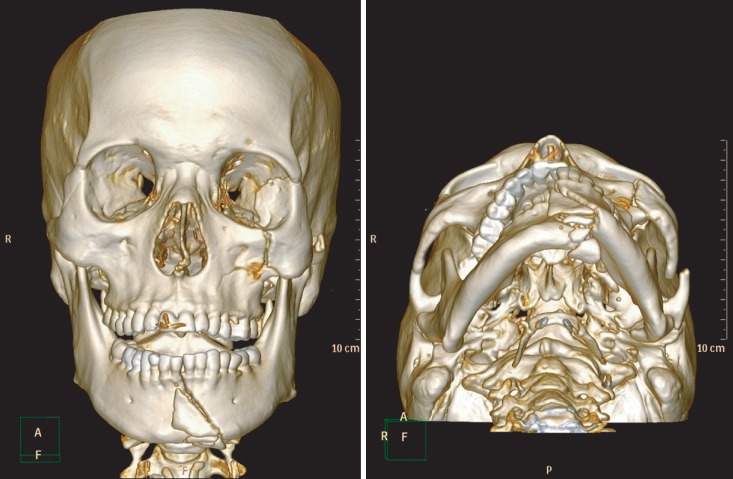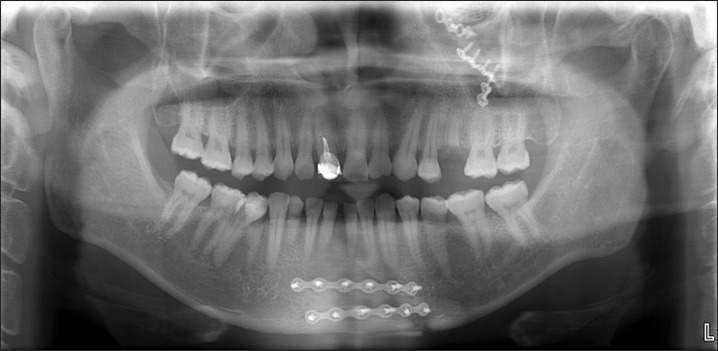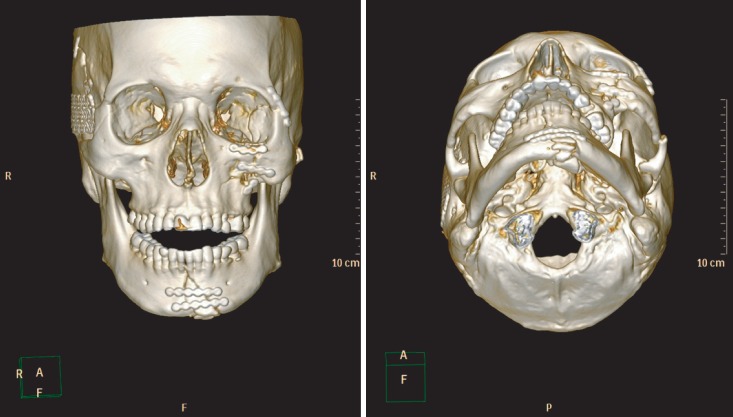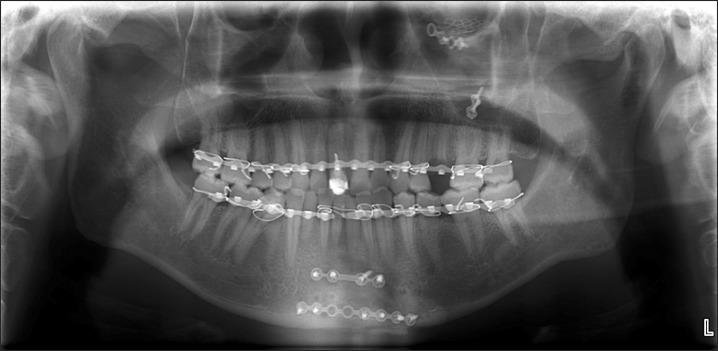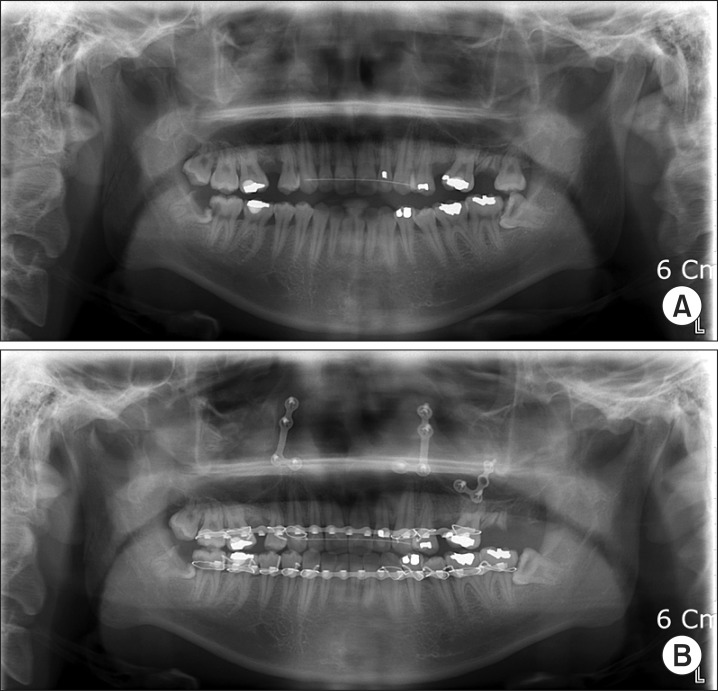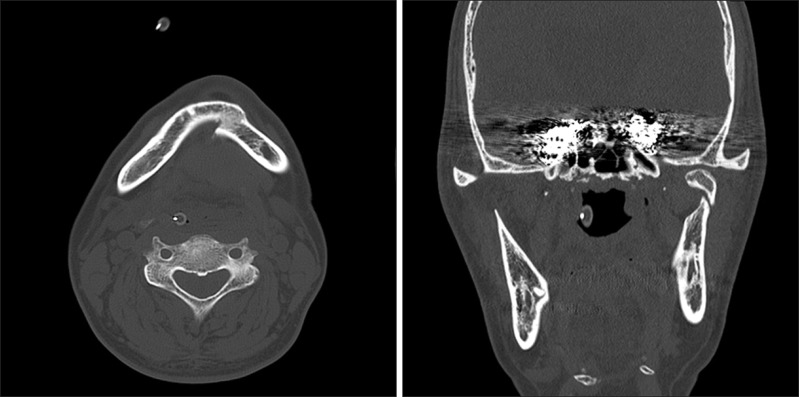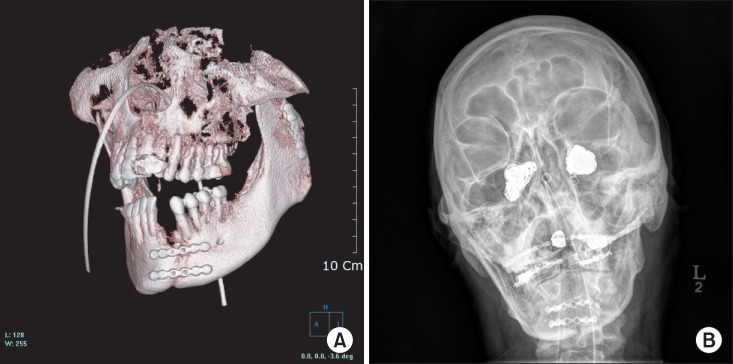J Korean Assoc Oral Maxillofac Surg.
2014 Apr;40(2):91-95. 10.5125/jkaoms.2014.40.2.91.
The treatment of malocclusion after open reduction of maxillofacial fracture: a report of three cases
- Affiliations
-
- 1Department of Oral and Maxillofacial Surgery, School of Dentistry, Chosun University, Gwangju, Korea. sgckim@chosun.ac.kr
- KMID: 1960961
- DOI: http://doi.org/10.5125/jkaoms.2014.40.2.91
Abstract
- The posttraumatic complications of jaw fractures related to jaw function and facial deformity include nonunion, malunion, malocclusion, temporomandibular joint dysfunction and facial asymmetry. This report presents cases referred to our department for revision of malunion and malocclusion following inadequate reduction of jaw fractures. Three patients with posttraumatic malocclusions caused by malunion were treated with a LeFort I osteotomy in one case and re-fracture in two cases. All of the patients exhibited stable results without further complications (e.g., malunion or malocclusion). Accurate preoperative diagnosis and proper anatomical reduction of the fracture segments are essential to preventing post-surgical malunion and malocclusion.
Keyword
MeSH Terms
Figure
Cited by 2 articles
-
Malocclusion after open reduction of midfacial fracture: a case report
Seong-Un Lim, Ki-Su Jin, Yoon-Sic Han, Ho Lee
J Korean Assoc Oral Maxillofac Surg. 2017;43(1):53-56. doi: 10.5125/jkaoms.2017.43.1.53.Who should take charge of maxillofacial surgery?
Young-Kyun Kim
J Korean Assoc Oral Maxillofac Surg. 2016;42(3):131-132. doi: 10.5125/jkaoms.2016.42.3.131.
Reference
-
1. Killey HC, Banks P. Killey's fractures of the mandible. 3rd ed. Bristol: Wright-PSG;1983.2. Moraes RB, Landes CA, Luz JG. Fixation of mandibular fractures with plates or miniplates: prospective study. Minerva Stomatol. 2010; 59:159–166. PMID: 20360663.3. Mathog RH, Toma V, Clayman L, Wolf S. Nonunion of the mandible: an analysis of contributing factors. J Oral Maxillofac Surg. 2000; 58:746–752. PMID: 10883689.
Article4. Li Z, Zhang W, Li ZB, Li JR. Abnormal union of mandibular fractures: a review of 84 cases. J Oral Maxillofac Surg. 2006; 64:1225–1231. PMID: 16860214.
Article5. Taher AA. Osteomyelitis of the mandible in Tehran, Iran. Analysis of 88 cases. Oral Surg Oral Med Oral Pathol. 1993; 76:28–31. PMID: 8351116.6. Assael LA. Evaluation of rigid internal fixation of mandible fractures performed in the teaching laboratory. J Oral Maxillofac Surg. 1993; 51:1315–1319. PMID: 8229410.
Article7. Punjabi AP, Thaller SR. Late complications of mandibular fractures. Oper Tech Plast Reconstr Surg. 1998; 5:266–274.
Article8. Schwimmer A. Mandibular pseudoarthrosis and non-unions. In : Greenberg AM, editor. Craniomaxillofacial fractures: principles of internal fixation using the AO/ASIF technique. New York: Springer-Verlag;1993. p. 77–84.9. Alpert B, Engelstad M, Kushner GM. Invited review: small versus large plate fixation of mandibular fractures. J Craniomaxillofac Trauma. 1999; 5:33–39. PMID: 11951257.10. Mathog RH, Boies LR Jr. Nonunion of the mandible. Laryngoscope. 1976; 86:908–920. PMID: 778516.
Article11. Mathog RH. Nonunion of the mandible. Otolaryngol Clin North Am. 1983; 16:533–547. PMID: 6355979.
Article12. Ellis E 3rd. Complications of rigid internal fixation for mandibular fractures. J Craniomaxillofac Trauma. 1996; 2:32–39. PMID: 11951481.
- Full Text Links
- Actions
-
Cited
- CITED
-
- Close
- Share
- Similar articles
-
- Malocclusion after open reduction of midfacial fracture: a case report
- Revision surgery for malocclusion after open reduction of mandibular fracture: a case report
- OPEN REDUCTION AND TRANSORAL FIXATION USING TROCHAR FOR MANDIBULAR SUBCONDYLE FRACTURE
- Clinical Applications of Endoscopic-Assisted Open Reduction and Internal Fixation of Subcondylar Fractures
- Re-treatment of malocclusion resulting from improper reduction of facial bone fracture

